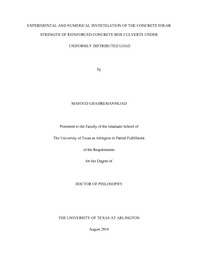| dc.description.abstract | This research resulted in the development of a new method for performing displacement control analysis of distributed loads to obtain the ultimate shear strength of structural components. A framework, consisting of several sub-frames, was designed to convert the single displacement applied at the top of the framework to equivalent uniformly-distributed forces applied to the beam. To validate the loading mechanism, using the proposed framework, the load was applied on the top of a reinforced concrete beam in the laboratory, and numerical studies were conducted. The shear capacity of the beam under a concentrated load at mid-span was compared with the shear capacity of a uniform load for four different a/d ratios (3, 4, 5, and 7). The results indicated that the strain in the longitudinal rebar, which is dependent upon the loading condition, strongly impacts the shear strength of a critical section of structural components. The shear strength of the critical sections of the R.C. beams studied in this research had uniformly distributed loads that were, on average, 76% greater than the shear strength of the same beam with a concentrated load at mid-span. The shear strength predictions of the AASHTO specification and the ACI318-14 code were evaluated for beams with shear behavioral mode. A parametric study of 24 RC beams was conducted, and the results indicated that AASHTO’s prediction for strain in longitudinal rebar differed about 19%, on average, from the results of the finite element method (FEM). For prediction of the β factor, however, the difference was about 61%. The ACI318-14’s formulation for the concrete shear strength (V_c) averaged 59% higher than the FEM results for the studied beams.
An increase in the fill height of buried box culverts leads to an increase in the thickness of the slab and wall, as well as in the number or size of longitudinal slab reinforcements required to resist flexure. This geometrical configuration imposes a shear behavioral mode. The second part of this study focuses on experimental and numerical approaches to determining the shear strength of reinforced concrete box culverts with uniformly distributed load on the top slab. Two sizes of reinforced concrete (R.C.) box culverts were experimentally and numerically investigated. The results from the verified numerical models differed from the ACI318-14 formulation for the shear strength of top slabs of R.C. box culverts. A parametric study of 108 cases using the verified analysis revealed that the shear strength of the top slabs of R.C. box culverts averaged 66% greater than the ACI318-14’s shear formulation. The ratio of V_FEM/V_(ACI318-14) decreased slightly when the span/rise increased; however, an increase in the span/top slab’s thickness led to a significant decrease in the V_FEM/V_(ACI318-14) ratio.
The finite element models of R.C. box culverts were calibrated by experimental data. Using the verified numerical models, several parameters were investigated that influence the shear strength of a R.C. box culvert’s top slab, such as span, rise, top slab’s thickness, etc. Consequently, the results of 288 case studies assessed the AASHTO’s methodology to determine the shear strength of the box culverts’ top slab. A comparison of analysis results with the equations in the specification, using the AASHTO approach, indicated an underestimation in the prediction of the concrete shear strength (the β factor); however, the difference in prediction of the strain value in the longitudinal rebar was reasonably acceptable. The comparison revealed, on average, an 89% difference in prediction of the β factor and a 19% difference in prediction of the strain in the longitudinal rebar in the shear critical section, at distance “d” from haunch. The nonlinear regression analysis proposed multi-variable formulations to predict the concrete shear strength in the shear critical section of the top slab of R.C. box culverts. | |


